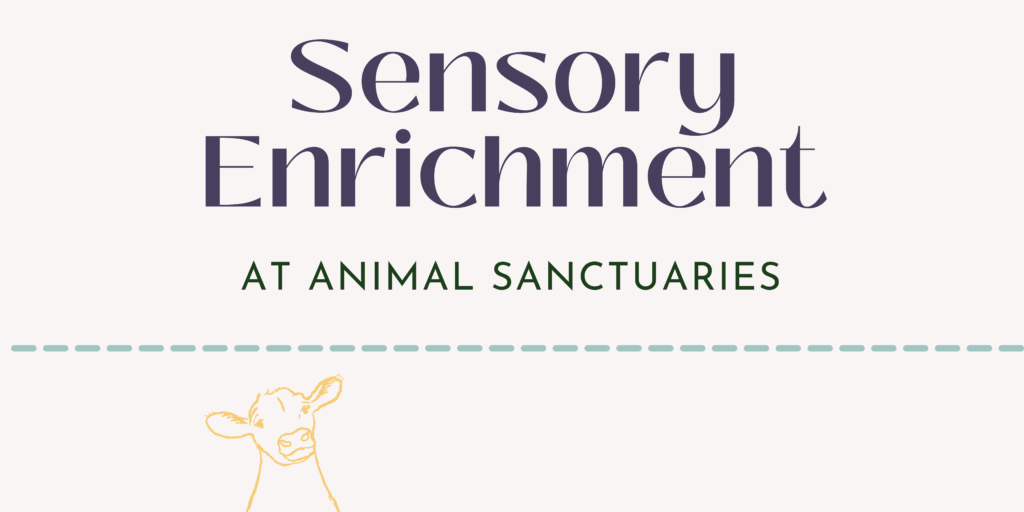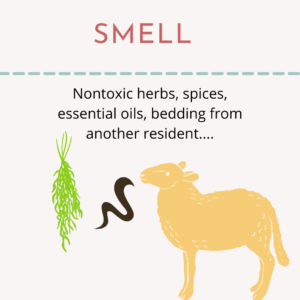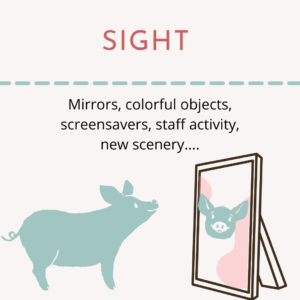
Engaging the senses can be a great way to provide enriching experiences for residents. Previously, we’ve talked about sensory and other types of enrichment in our Time To Thrive series. In this resource, we will look at how touch, sound, sight, taste, and smell have a place in enrichment programs. What are some enrichment strategies that involve the senses? Let’s take a look!
Sensory Enrichment
Sensory enrichment seeks to stimulate a sense or multiple senses, creating depth and variety in a resident’s life. Sensory enrichment includes auditory, gustatory, tactile, olfactory, and visual forms of enrichment. We will look at each of these individually.
Sensory Enrichment Overlap
You will notice as we cover each area of sensory enrichment that some categories overlap. A tasty treat can smell amazing, taste sweet, feel crunchy, and look interesting. This is only one example. Perhaps one of the best examples is sensory walks. Certain residents may benefit from sensory walks. It involves walking with a resident outside of their living spaceThe indoor or outdoor area where an animal resident lives, eats, and rests. to safely explore the world around them. Imagine being a horse and walking under a large shady tree and feeling the leaves crunch under your hooves and the musty scent of them mixing with the scent of water nearby. Along the way, you encounter the song of different birds, a small mammal chittering, and– oh! you step in a puddle which you stop to inspect. All along your caregiverSomeone who provides daily care, specifically for animal residents at an animal sanctuary, shelter, or rescue. talks to you, occasionally reaching out a hand to give you a nice scritch. Keep this in mind when brainstorming sensory enrichment ideas!
Auditory (Sound)
Auditory enrichment can include things like strumming a guitar for an engaged resident, playing the radio or sounds of other animals of their species, or providing objects that make sounds when manipulated (like bells). The type of auditory enrichment used can depend on the species it is intended for and the individual.
Check out our Time To Thrive resource on the importance of considering species and individuals when brainstorming enrichment ideas. In the case of auditory enrichment, different species have different hearing abilities, so care must be taken that any noise or music played doesn’t end up being an unpleasant or harmful experience for residents. For example, CowsWhile "cows" can be defined to refer exclusively to female cattle, at The Open Sanctuary Project we refer to domesticated cattle of all ages and sexes as "cows." have nearly double the frequency range of humans, and auditory enrichment should be implemented with this in mind! Studies have shown that cows can become stressed in noisy environments. If you wish to try auditory enrichment, err on the side of caution and keep sounds low. In addition to species-specific considerations, always be mindful of the individual. Is a resident hard of hearing? Are they easily startled? It is best to do your research beforehand in order to prevent negative experiences for residents.

Olfactory (Smell)
In addition to being able to provide a novel scent in a resident’s environment to explore, some scents have been studied to see how they might affect the behavior and physiological states of different species. Scent can be a powerful (careful it isn’t too powerful!) addition to an enrichment schedule. Keep in mind that different species will also have different abilities when it comes to scent. Pigs, for example, have an excellent sense of smell, making them great candidates for olfactory enrichment, though generally, most resident species have the potential to find different scents stimulating or engaging. Try introducing scents by adding them to static grooming brushes. Some studies indicate that pigs prefer sweet scents over savory scents. In one case, pigs chose vanilla over rosemary and banana over peanut-scented items. In yet another study, piglets were attracted to maple. While pigs in another study showed a preference for natural earthy smells of grass, moist soil, and dried mushrooms, out of the synthetic fragrances presented, they preferred strawberry over orange, vanilla, and mint.

Visual (Sight)
Visual enrichment can come in many forms and has the potential to be part of a dynamic living environment for residents. Acrylic mirrors and videos of other happy residents may be helpful for certain species and individuals when they are isolated due to injury or illness. TV and changing screensavers can also be a handy enrichment option when a resident must rest in a small space. Do a little research on the resident species you would like to provide visual enrichment for. Different species have different eye anatomy, allowing them to see different colors. Some species may even have colors they prefer. In studies where ducksUnless explicitly mentioned, we are referring to domesticated duck breeds, not wild ducks, who may have unique needs not covered by this resource. were given differently colored whiffle balls to play with, they showed more interest in blue and green enrichment toys than red or white! Brightly colored objects can add some novelty to a resident’s day. Even doing different work activities where residents can see can be enriching in some cases.

Tactile (Touch)
Tactile enrichment can be so much fun! It can be as simple as adding a pile of chicken-safe leaves for chicken residents to scratch through. Other examples include simply putting a pile of fresh dirt, or sand (be sure sand impaction isn’t an issue for the species and isn’t mixed with nutritional enrichment), or adding a nice dust bathing area. Anything that a resident can touch that would feel different than what they touch every day can be enriching. Attach push broom heads to fencing or other secure areas around both indoor and outdoor living spaces for donkey residents for a good scratch. Add things they can manipulate, balls with smooth surfaces, and logs with rough bark. There are so many options!

Gustatory (Taste)
While nutritional enrichment is in its own category, we would be remiss if we didn’t at least mention it. As you no doubt are aware, many residents love a good snack. There’s a myriad of ways to pique the interest of residents with various treats. One fun way is to add chopped-up treats to a mold, add water and stick it in the freezer, and pop it out for residents during those hot weather days!

Species-Specific Sensory Enrichment
Check out these links to read tips about sensory enrichment for different species. Learning as much as you can about the species will help you develop successful enrichment strategies.
The Rule Of Enrichment!
You’ll hear us say it many times, but with sensory enrichment strategies, and all other forms of enrichment, it’s only enriching if a resident finds it enriching! A resident who is bored, fearful, or upset at proffered enrichment is not having an enriching experience!
We hope this resource has given you the inspiration to add sensory enrichment into the lives of your sanctuary residents. The benefits of enrichment are many. You can utilize sensory and other forms of enrichment to help ensure your residents live their best lives possible. For more general information about the different types of enrichment, check out this resource!
SOURCES:
Five Enrichment Categories | The Shape Of Enrichment
Cattle | Animal Behavior (Non-Compassionate Source)
Effect Of Olfactory Stimulation During Suckling On Agonistic Behavior In Weaned Pigs | Journal Of Swine Production (Non-Compassionate Source)
The Influence Of Aromatized Environmental Enrichment Objects With Changeable Aromas On The Behaviour Of Weaned Piglets | Veterinarski Arhiv (Non-Compassionate Source)
Odors And Pheromones: Influences Of Olfaction On Behavior, Physiology, And Performance To Reduce Stress In Pigs | Texas Tech University (Non-Compassionate Source)
The Effects Of Environmental Enrichment Devices On Feather Picking In Ccommercially Housed Pekin Ducks | Poultry Science (Non-Compassionate Source)
Non-Compassionate Source?
If a source includes the (Non-Compassionate Source) tag, it means that we do not endorse that particular source’s views about animals, even if some of their insights are valuable from a care perspective. See a more detailed explanation here.






